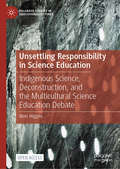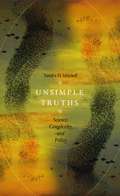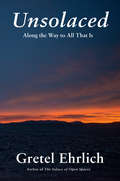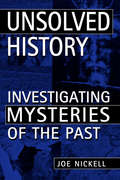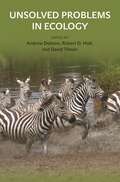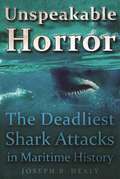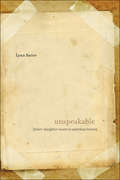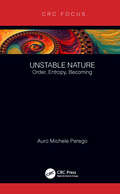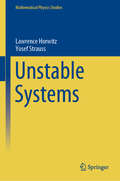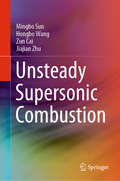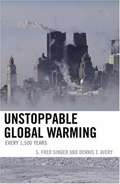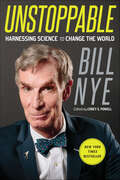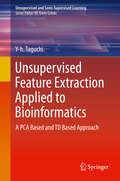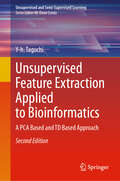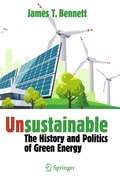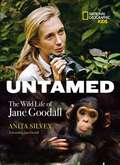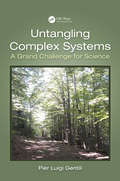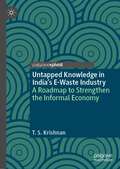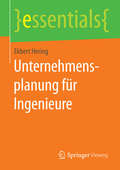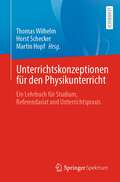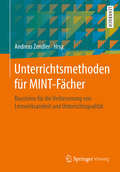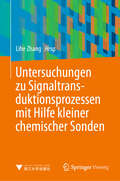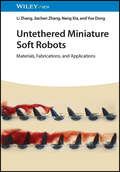- Table View
- List View
Unsettling Responsibility in Science Education: Indigenous Science, Deconstruction, and the Multicultural Science Education Debate (Palgrave Studies in Educational Futures)
by Marc HigginsThis open access book engages with the response-ability of science education to Indigenous ways-of-living-with-Nature. Higgins deconstructs the ways in which the structures of science education—its concepts, categories, policies, and practices—contribute to the exclusion (or problematic inclusion) of Indigenous science while also shaping its ability respond. Herein, he undertakes an unsettling homework to address the ways in which settler colonial logics linger and lurk within sedimented and stratified knowledge-practices, turning the gaze back onto science education. This homework critically inhabits culture, theory, ontology, and history as they relate to the multicultural science education debate, a central curricular location that acts as both a potential entry point and problematic gatekeeping device, in order to (re)open the space of responsiveness towards Indigenous ways-of-knowing-in-being.
Unsimple Truths: Science, Complexity, and Policy
by Sandra D. MitchellThe world is complex, but acknowledging its complexity requires an appreciation for the many roles context plays in shaping natural phenomena. In Unsimple Truths,Sandra Mitchell argues that the long-standing scientific and philosophical deference to reductive explanations founded on simple universal laws, linear causal models, and predict-and-act strategies fails to accommodate the kinds of knowledge that many contemporary sciences are providing about the world. She advocates, instead, for a new understanding that represents the rich, variegated, interdependent fabric of many levels and kinds of explanation that are integrated with one another to ground effective prediction and action. Mitchell draws from diverse fields including psychiatry, social insect biology, and studies of climate change to defend "integrative pluralism"---a theory of scientific practices that makes sense of how many natural and social sciences represent the multi-level, multi-component, dynamic structures they study. She explains how we must, in light of the now-acknowledged complexity and contingency of biological and social systems, revise how we conceptualize the world, how we investigate the world, and how we act in the world. Ultimately Unsimple Truths argues that the very idea of what should count as legitimate science itself should change.
Unsolaced: Along the Way to All That Is
by Gretel EhrlichFrom the author of the enduring classic The Solace of Open Spaces, here is a wondrous meditation on how water, light, wind, mountain, bird, and horse have shaped her life and her understanding of a world besieged by a climate crisis. Amid species extinctions and disintegrating ice sheets, this stunning collection of memories, observations, and narratives is acute and lyrical, Whitmanesque in breadth, and as elegant as a Japanese teahouse. &“Sentience and sunderance,&” Ehrlich writes. &“How we know what we know, who teaches us, how easy it is to lose it all.&” As if to stave off impending loss, she embarks on strenuous adventures to Greenland, Africa, Kosovo, Japan, and an uninhabited Alaskan island, always returning to her simple Wyoming cabin at the foot of the mountains and the trail that leads into the heart of them.
Unsolved History: Investigating Mysteries of the Past
by Joe NickellWhat constitutes historical truth is often subject to change. Joe Nickell demonstrates the techniques used in solving some of the world's most perplexing mysteries, such as the authenticity of Abraham Lincoln's celebrated Bixby letter, the 1913 disappearance of writer and journalist Ambrose Bierce, and the apparent real-life model for a mysterious character in a novel by Nathaniel Hawthorne. Nickell also uses newly uncovered evidence to further investigate the identity of the Nazi war criminal known as ""Ivan the Terrible.""
Unsolved Problems in Ecology
by Andrew Dobson Robert D. Holt David TilmanLeading ecologists discuss some of the most compelling open questions in the field todayUnsolved Problems in Ecology brings together many of the world's leading ecologists to discuss the most fundamental research questions confronting the field today. This diverse and thought-provoking collection of essays spans virtually all of the key subfields of the discipline, from behavioral and evolutionary ecology to population biology, community ecology, ecosystem ecology, disease ecology, and conservation biology. These essays are intended to stoke curiosity, challenge prevailing wisdom, and provoke new ways of thinking about ecology in light of new technologies and unprecedented environmental challenges brought on by climate and land-use change. Authoritative and accessible, Unsolved Problems in Ecology is ideal for graduate students in the early stages of their scientific careers and an essential resource for seasoned ecologists looking for exciting new directions to take their research.Sheds light on modern ecology's most important and compelling open questionsFeatures thought-provoking contributions from more than two dozen world-class ecologistsCovers behavior, evolution, communities, ecosystems, resource management, and moreDiscusses ways to raise the financial and intellectual profile of the disciplineAn invaluable resource for graduate students as well as seasoned ecologists
Unspeakable Horror: The Deadliest Shark Attacks in Maritime History
by Joseph B. HealyThe story of the USS Indianapolis is well-known. After delivering crucial components of the atomic bomb that would level Hiroshima in 1945, the Indianapolis was sunk by a Japanese submarine in the South China Sea. Of the nearly 1,200 men aboard, 900 survived the torpedoing, spilling into the sea. White tip sharks began attacking the next morning and after four days only 300 sailors were alive to rescue. Less famous are the many stories of ships sinking in shark-infested waters with gruesome results. Such as the Cape San Juan, a US troop transport ship that was torpedoed by a Japanese submarine in the Pacific Ocean near the Fiji Islands; nearly 700 of the survivors were killed by sharks. Or the HMS Birkenhead, which sunk off Danger Point, South Africa, in 1852, resulting in 440 shark-related fatalities. In 1927, the luxury Italian cruise liner Principessa Maldafa sank ninety miles off the coast of Albrohos Island while heading to Porto Seguro, Brazil. Nearly 300 who survived the wreck were killed by sharks. In 1909, the French steamer La Seyne collided with British India Steamship Co. liner Onda near Singapore, twenty-six miles from land. One hundred and one people were eventually killed by sharks. In the water, human intelligence is no match for a shark’s brutal, destructive instincts. Sharks are born to kill and eat: They detect distress, smell blood—and attack. Marine disasters such as those above result in humans becoming prey, floating in inner space as shadowy sharks swim below, ready to attack. Helpless to save yourself—floating and waiting, watching the malevolent creatures circle, knowing what will happen . . . a sudden swirl of water, a cloud of blood, the searing pain . . . until there is no more. This is unspeakable horror
Unspeakable: Father-Daughter Incest in American History
by Lynn SaccoFirst place, Large Nonprofit Publishers Illustrated Covers, 2010 Washington Book PublishersNamed one of the Top Five Books of 2009 by Anne Grant, The Providence JournalThis history of father-daughter incest in the United States explains how cultural mores and political needs distorted attitudes toward and medical knowledge of patriarchal sexual abuse at a time when the nation was committed to the familial power of white fathers and the idealized white family.For much of the nineteenth century, father-daughter incest was understood to take place among all classes, and legal and extralegal attempts to deal with it tended to be swift and severe. But public understanding changed markedly during the Progressive Era, when accusations of incest began to be directed exclusively toward immigrants, blacks, and the lower socioeconomic classes. Focusing on early twentieth-century reform movements and that era’s epidemic of child gonorrhea, Lynn Sacco argues that middle- and upper-class white males, too, molested female children in their households, even as official records of their acts declined dramatically. Sacco draws on a wealth of sources, including professional journals, medical and court records, and private and public accounts, to explain how racial politics and professional self-interest among doctors, social workers, and professionals in allied fields drove claims and evidence of incest among middle- and upper-class white families into the shadows. The new feminism of the 1970s, she finds, brought allegations of father-daughter incest back into the light, creating new societal tensions. Against several different historical backdrops—public accusations of incest against "genteel" men in the nineteenth century, the epidemic of gonorrhea among young girls in the early twentieth century, and adult women’s incest narratives in the mid-to late twentieth century—Sacco demonstrates that attitude shifts about patriarchal sexual abuse were influenced by a variety of individuals and groups seeking to protect their own interests.
Unstable Nature: Order, Entropy, Becoming
by Auro Michele PeregoUnstable Nature is a popular science book offering a journey through the concept of instability in modern science with a focus on physics. Conceived for the curious reader wishing to go deeper in the fascinating and not yet popularised world of instabilities, it provides an immersion into paradoxical and unexpected phenomena - some of which hides in plain sight in our daily lives. The book is written without technical jargon, and new concepts and terminology needed for the narrative are introduced gradually based on examples taken from accessible everyday life. The chapters are connected through a path that starts from exploring instabilities at the planetary scale and then passes through a description of unstable dynamics in macroscopic settings such as in human mechanical artifacts, fluid waves, animal skin, vegetation structures, and chemical reactions, finally reaching the sub atomic scale and the biological processes of human thought. Before concluding with some general philosophical remarks, a modern landscape about the possibility of seeing instabilities not only as a detrimental effect but as resources to be harnessed for technology is explored. The book is enriched by a variety of professional anecdotes stemming from the direct research experience of the author. It features numerous connections of scientific concepts presented with other branches of the human experience and knowledge including philosophy, engineering, history of science, biology, chemistry, mathematics and computer science, poetry, and meditation. Key Features: Presents an exciting introduction to the topic, which is accessible to those without a scientific background Explores milestone discoveries in the history of the concept of instability in physics Contains anecdotes of key figures from the field, including James C. Maxwell, Alan Turing, Vladimir Zakharov, Edward Lorenz, Enrico Fermi, and Mary Tsingou
Unstable Systems (Mathematical Physics Studies)
by Lawrence Horwitz Yosef StraussThis book focuses on unstable systems both from the classical and the quantum mechanical points of view and studies the relations between them. The first part deals with quantum systems. Here the main generally used methods today, such as the Gamow approach, and the Wigner-Weisskopf method, are critically discussed. The quantum mechanical Lax-Phillips theory developed by the authors, based on the dilation theory of Nagy and Foias and its more general extension to approximate semigroup evolution is explained.The second part provides a description of approaches to classical stability analysis and introduces geometrical methods recently developed by the authors, which are shown to be highly effective in diagnosing instability and, in many cases, chaotic behavior. It is then shown that, in the framework of the theory of symplectic manifolds, there is a systematic algorithm for the construction of a canonical transformation of any standard potential model Hamiltonian to geometric form, making accessible powerful geometric methods for stability analysis in a wide range of applications.
Unsteady Flow in Open Channels
by Jurjen Battjes Robert Jan LabeurPractitioners in water engineering rely on a thorough understanding of shallow water flows in order to safeguard our habitat, while at the same time sustaining the water environment. This book proposes a unified theoretical framework for the different types of shallow flow, providing a coherent approach to interpret the behaviour of such flows, and highlighting the similarities and differences. Every major topic in the book is accompanied by worked examples illustrating the theoretical concepts. Practical examples, showcasing inspiring research and engineering applications from the past and present, provide insight into how the theory developed. The book is also supplemented by a range of online resources, available at www. cambridge. org/battjes, including problem sets and computer codes. A solutions manual is available for instructors. This book is intended for students and professionals working in environmental water systems, in areas such as coasts, rivers, harbours, drainage, and irrigation canals.
Unsteady Supersonic Combustion
by Mingbo Sun Hongbo Wang Zun Cai Jiajian ZhuThis book describes the unsteady phenomena needed to understand supersonic combustion. Following an initial chapter that introduces readers to the basic concepts in and classical studies on unsteady supersonic combustion, the book highlights recent studies on unsteady phenomena, which offer insights on e.g. interactions between acoustic waves and flames, flow dominating instability, ignition instability, flame flashback, and near-blowout-limit combustion. In turn, the book discusses in detail the fundamental mechanisms of these phenomena, and puts forward practical suggestions for future scramjet design.
Unstoppable Global Warming: Every 1500 Years
by S. Fred Singer Dennis T. AveryAdmitting the existence of global warming, but denying that there is scientific consensus surrounding its causes and the threat it poses, Singer (George Mason U.) and Avery (of the Hudson Institute) argue that recent warming is part of a natural cycle of warming and chilling connected to changes in the sun and dispute the evidence regarding humanity's role in driving it through the production of carbons. They also suggest that it is likely to be much less of a problem than many have predicted. Annotation ©2006 Book News, Inc., Portland, OR (booknews.com)
Unstoppable: Harnessing Science to Change the World
by Bill Nye“Climate change is coming. What can we do about it? TV’s ‘Science Guy’ has some answers. . . . An important message delivered in a winning manner.” —Kirkus ReviewsJust as World War II called an earlier generation to greatness, so the climate crisis is calling today’s rising youth to action: to create a better future.In Unstoppable, Bill Nye expands the message for which he is best known and beloved. That message is that with a combination of optimism and scientific curiosity, obstacles become opportunities, and the possibilities of our world become limitless. With a scientist’s thirst for knowledge and an engineer’s vision of what can be, Bill Nye sees today’s environmental issues not as insurmountable problems but as chances for our society to rise to the challenge and create a cleaner, healthier, smarter world. We need not accept that transportation consumes half our energy, and that two-thirds of the energy you put into your car is immediately thrown away out the tailpipe. We need not accept that dangerous emissions are the price we must pay for a vibrant economy and a comfortable life. Above all, we need not accept that we will leave our children a planet that is dirty, overheated, and depleted of resources. As Bill shares his vision, he debunks some of the most persistent myths and misunderstandings about global warming. When you are done reading, you’ll be enlightened and empowered. Chances are, you’ll be smiling, too, ready to join Bill and change the world.
Unsupervised Feature Extraction Applied to Bioinformatics: A PCA Based and TD Based Approach (Unsupervised and Semi-Supervised Learning)
by Y-h. TaguchiThis book proposes applications of tensor decomposition to unsupervised feature extraction and feature selection. The author posits that although supervised methods including deep learning have become popular, unsupervised methods have their own advantages. He argues that this is the case because unsupervised methods are easy to learn since tensor decomposition is a conventional linear methodology. This book starts from very basic linear algebra and reaches the cutting edge methodologies applied to difficult situations when there are many features (variables) while only small number of samples are available. The author includes advanced descriptions about tensor decomposition including Tucker decomposition using high order singular value decomposition as well as higher order orthogonal iteration, and train tenor decomposition. The author concludes by showing unsupervised methods and their application to a wide range of topics. Allows readers to analyze data sets with small samples and many features;Provides a fast algorithm, based upon linear algebra, to analyze big data;Includes several applications to multi-view data analyses, with a focus on bioinformatics.
Unsupervised Feature Extraction Applied to Bioinformatics: A PCA Based and TD Based Approach (Unsupervised and Semi-Supervised Learning)
by Y-h. TaguchiThis updated book proposes applications of tensor decomposition to unsupervised feature extraction and feature selection. The author posits that although supervised methods including deep learning have become popular, unsupervised methods have their own advantages. He argues that this is the case because unsupervised methods are easy to learn since tensor decomposition is a conventional linear methodology. This book starts from very basic linear algebra and reaches the cutting edge methodologies applied to difficult situations when there are many features (variables) while only small number of samples are available. The author includes advanced descriptions about tensor decomposition including Tucker decomposition using high order singular value decomposition as well as higher order orthogonal iteration, and train tensor decomposition. The author concludes by showing unsupervised methods and their application to a wide range of topics.
Unsustainable: The History and Politics of Green Energy
by James T. BennettThis book examines the history, politics, and economics of alternative energy. Since the energy crisis of the 1970s, governments around the world have subsidized and otherwise incentivized alternative forms of energy to reduce dependence on fossil fuels. This search has taken on added urgency in the twenty-first century, as the specter of climate change has engendered ambitious state-level renewable portfolio standards, enhanced federal incentives, and inspired “100% renewable” electrical generation targets in such states as Vermont and Hawaii. To save the planet from destruction, wind, solar, and other renewable energy alternatives must replace fossil fuels. But how did we get here and what is the cost? After an in-depth study of the Carter administration's synthetic fuels program, the focus shifts to the two most prominent, perhaps most promising, and certainly most promoted—and government subsidized—“green” and “renewable” energies today: wind and solar. Because wind has made the most headway and drawn the most controversy, it receives the most attention. Although the primary focus is on the American experience with renewable energy, the policies and politics of renewables in Scotland, Wales, Denmark, Spain, and other European nations are also discussed. Issues considered in the book include the nature and efficacy of renewable subsidies; the employment of federal and state tax codes to encourage renewables; the lobbies and interest groups that campaign for government support of renewables; and the fierce battles over the siting of renewable facilities. Unlike other works on this subject, the book probes in depth the nature of the opposition to wind and solar, both in the matter of siting and in their worthiness as recipients of substantial government assistance.
Untamed: The Wild Life of Jane Goodall
by Anita SilveyJane Goodall, one of the most recognized scientists in the Western world, became internationally famous because of her ability to observe and connect with another species. A girl of humble beginnings and training, she made scientific breakthroughs thought impossible by more experienced field observers when she was only in her twenties. Then these animals shaped Jane's life. She began tirelessly fighting to protect the environment so that chimpanzees and other animals will continue have a place and a future on our planet. Jane Goodall continues to leave the modern world with an extraordinary legacy and has changed the scientific community forever.
Untangling Complex Systems: A Grand Challenge for Science
by Pier GentiliComplex Systems are natural systems that science is unable to describe exhaustively. Examples of Complex Systems are both unicellular and multicellular living beings; human brains; human immune systems; ecosystems; human societies; the global economy; the climate and geology of our planet. This book is an account of a marvelous interdisciplinary journey the author made to understand properties of the Complex Systems. He has undertaken his trip, equipped with the fundamental principles of physical chemistry, in particular, the Second Law of Thermodynamics that describes the spontaneous evolution of our universe, and the tools of Non-linear dynamics. By dealing with many disciplines, in particular, chemistry, biology, physics, economy, and philosophy, the author demonstrates that Complex Systems are intertwined networks, working in out-of-equilibrium conditions, which exhibit emergent properties, such as self-organization phenomena and chaotic behaviors in time and space.
Untangling Complexity—Peace Building Engineering: Systems Thinking & Complexity Management to Support Community Development (Synthesis Lectures on Engineers, Technology, & Society #29)
by Camilo Andrés Navarro ForeroThis book examines how the rapid acceleration and interconnection of globalization comes with the need for more flexible and adaptable solutions to complex problems and solutions. It describes and demonstrates possible combinations of methods and methodologies to address the complex problems that the world offers us today. Sharing meaningful experiences of the application of workshops in mixed public private companies and with vulnerable communities and peacebuilding communities. The text offers readers, who are looking for tools to face complexity and enhance their projects, real-world examples and accessible methods. The book is based on advanced engineering tools however it is understandable and accessible to a broad audience.This book is for decision makers involved with social complex systems who are uncertain about how they should start and proceed. Discussions on new methodologies to support engineering interventions with communities are being shown. A new multi-methodology proposal called “Complexity Funnel Methodology” (CFM) dissected in “Social Transformation Workshops” (STW) is provided and discussed. It is used with combinations of different methods and methodologies of critical Systems thinking. The implementation of this methodology is described using a case study approach.
Untapped Knowledge in India’s E-Waste Industry: A Roadmap to Strengthen the Informal Economy (Palgrave Advances in the Economics of Innovation and Technology)
by T. S. KrishnanThis book focuses on the economic, political, and cultural factors that make up India’s “informal processors,” which are the highly networked, multi-generational systems that reuse, repurpose, and otherwise dispose of 80% of India’s electronic waste. The research includes insight from more than ninety interviews with forty-nine key stakeholders working within India’s e-waste processing industry. This vital resource explores the complexities of the e-waste industry, and it comprehensively explains the importance of developing context-specific solutions that leverage the inherent strengths of informal processors. The resulting resource offers a counterpoint to mainstream arguments that dismiss the value of expertise from informal processors.
Unternehmensplanung für Ingenieure (essentials)
by Ekbert HeringDie meisten Ingenieure in der Praxis übernehmen Führungsverantwortung. Dabei ist vor allem die Planungskompetenz gefragt. Es muss einerseits die nahe Zukunft geplant werden, beispielsweise für Umsätze, Ergebnisse und Liquiditäten von Sparten, Produkten und in Märkten für die nächsten drei Jahre. Andererseits ist es erforderlich, zukünftige Entwicklungen des Unternehmens in einem dynamischen Wettbewerbsumfeld zu planen. Diese strategische Planung ist die entscheidende Weichenstellung für den Erfolg der Zukunft. Deshalb werden in diesem Band die Methoden der strategischen und operativen Planung vorgestellt. In einem gesamtheitlichen Rahmen werden die Einzelpläne diskutiert (z. B. Umsatz-, Kosten-, Finanz- und Personalpläne) und ihr zeitlicher Horizont bestimmt sowie der zeitliche Ablauf vorgestellt.
Unterrichtskonzeptionen für den Physikunterricht: Ein Lehrbuch für Studium, Referendariat und Unterrichtspraxis
by Horst Schecker Thomas Wilhelm Martin HopfWelche Möglichkeiten habe ich für die Gestaltung des nächsten Themas meines Physikunterrichts? Diese Frage stellt sich Lehrkräften immer wieder. Dieses Lehrbuch hilft Lehramtsstudierenden, Referendaren und Lehrkräften dabei, Unterrichtskonzeptionen und ihre Leitideen besser zu verstehen und mögliche Alternativen für den eigenen Unterricht kennenzulernen. Die Autorinnen und Autoren stellen verschiedene Unterrichtskonzeptionen detailliert vor, die im deutschsprachigen Raum für den Physikunterricht entwickelt und in der Schulpraxis erprobt wurden. Zu allen Konzeptionen werden Quellen für Unterrichtsmaterialien angegeben. Die Kapitel beinhalten Übungen, die Leserinnen und Leser zum Durchdenken der Inhalte anregen.Im einführenden Kapitel des Werkes wird erläutert, in welchen Entwicklungszusammenhängen Unterrichtskonzeptionen entstehen. In vierzehn folgenden Themenkapiteln werden jeweils mehrere konkrete Unterrichtskonzeptionen mit ihren Leitideen und ihren Unterrichtsgängen vorgestellt. Die Inhaltsbereiche erstrecken sich vom Anfang der Sekundarstufe I bis hin zur gymnasialen Oberstufe. Dazu zählen u. a. die Optik, Mechanik, Wärmelehre, Elektrizitätslehre, Magnetismus, Felder, Quantenphysik, aber auch Nature of Science, fächerübergreifender Unterricht und prozessbezogene Kompetenzen.Die Leser und Leserinnen werden nach der Lektüre• Unterrichtskonzeptionen in wichtigen Gebieten der Schulphysik kennen,• wissen, was die jeweiligen Grundideen, Ziele und Elementarisierungen sind,• wissen, wo man Unterrichtsmaterialien zu den Unterrichtskonzeptionen findet,• die eigenen Vorstellungen, wie man ein Thema unterrichten sollte, durchdacht und überdacht haben.Leserinnen und Leser werden sich mit verschiedenen Zugängen, ein Thema zu unterrichten, beschäftigen und dadurch ihr Unterrichtsrepertoire erweitern können.
Unterrichtsmethoden für MINT-Fächer
by Andreas ZendlerMathematik, Informatik, Naturwissenschaften (Biologie, Chemie, Physik) und Technik - seit Jahren findet in der breiten Öffentlichkeit eine angeregte Diskussion über diese sogenannten MINT-Fächer statt. Denn das in den MINT-Fächern vermittelte Wissen ist die unverzichtbare Grundlage für die Ausbildung der in Deutschland dringend benötigten Fachkräfte. Darum fordern Politik und Wirtschaft eine stärkere Gewichtung der Fächer, aber auch eine Verbesserung der Unterrichtsqualität. Dieses Buch stellt 20 verschiedene, wissenschaftlich fundierte Methoden für den MINT-Unterricht vor und erläutert die Rolle der digitalen Medien als fächerübergreifendes Element. Die interdisziplinäre Betrachtungsweise bietet Lehrern einen umfassenden Überblick über die verschiedenen Möglichkeiten und Ansätze für den eigenen Unterricht. Für jede der vorgestellten Methoden geben die Autoren wissenschaftliche fundierte Einschätzungen zu ihrer Lerneffektivität und erleichtern so Lehrkräften die Auswahl der geeignetsten Methoden für den eigenen Unterricht. Detaillierte Unterrichtsmodelle helfen bei der Umsetzung in der Praxis. Damit erhalten Lehrer und Lehramtsstudenten einen umfassenden Einblick in die effektivsten Unterrichtsmodelle für ein prozess- und ergebnisorientiertes Lernen in den MINT-Fächern. Dieses Buch lässt sich ideal fächerübergreifend einsetzen und dient dazu, die Lerneffektivität speziell im MINT-Unterricht bei Schülerinnen und Schülern zu verbessern.
Untersuchungen zu Signaltransduktionsprozessen mit Hilfe kleiner chemischer Sonden
by Lihe ZhangIn diesem Buch wird ein umfangreiches Forschungsprogramm zur Erforschung von Signaltransduktionsprozessen mithilfe von Sonden mit kleinen Molekülen vorgestellt. Das Programm wurde von der National Natural Science Foundation of China während des 11. Fünfjahresplans ins Leben gerufen, der im Oktober 2008 begann und Ende 2016 abgeschlossen wurde. Der Bericht fasst zunächst die allgemeinen wissenschaftlichen Ziele und den aktuellen Stand der Signaltransduktionsforschung in China und an der internationalen Grenze zusammen. Basierend auf den neuen Methoden und Technologien, die im Bereich der niedermolekularen Sonden erreicht wurden, veranschaulicht dieses Buch die molekularen Schlüsselereignisse bei Signaltransduktionsprozessen in lebenden Systemen und zeigt die Regulation der Signaltransduktion auf. Dies trägt dazu bei, neue Ideen und Strategien für die Diagnose und Vorbeugung von schweren Krankheiten zu erforschen. Darüber hinaus werden in diesem Buch durch die interdisziplinäre Zusammenarbeit von Biologie und Chemie einige wichtige wissenschaftliche Probleme in der Biologie gelöst und neue Entwicklungen auf diesen Gebieten gefördert. Zu diesen Bereichen gehören die Herstellung von Sonden aus kleinen Molekülen zur Untersuchung der Signaltransduktion und die Entwicklung von Nachweismethoden zur Erfassung von Informationen über die Aktivitäten von Biomakromolekülen. Aufgrund seines Umfangs ist das Buch für Forscher interessant, die in den Bereichen organische Chemie, Naturstoffchemie, medizinische Chemie, analytische Chemie und physikalische Chemie arbeiten. Es fördert auch die multidisziplinäre Zusammenarbeit zwischen Chemie, Medizin, Materialwissenschaft und Biologie.
Untethered Miniature Soft Robots: Materials, Fabrications, and Applications
by Li Zhang Yue Dong Jiachen Zhang Neng XiaUntethered Miniature Soft Robots Reference on achieving contactless manipulation of soft robots, detailing high level concepts and perspectives and technical skills of soft robots Untethered Miniature Soft Robots: Materials, Fabrications, and Applications introduces the emerging field of miniature soft robots and summarizes the recent rapid development in the field to date, describing different types of functional materials to build miniature soft robots, such as silicone elastomer, carbon-based materials, hydrogels, liquid crystal polymer, flexible ferrofluid, and liquid metal, and covering the material properties, fabrication strategies, and functionalities in soft robots together with their underlying mechanisms. The book discusses magnetically, thermally, optically, and chemically actuated soft robots in depth, explores the many specific applications of miniature soft robots in biomedical, environmental, and electrical fields and summarizes the development of miniature soft robots based on soft matter, fabrication strategies, locomotion principles, sensing and actuation mechanisms. In closing, the text summarizes the opportunities and challenges faced by miniature soft robots, providing expert insight into the possible futures of this field. Written by four highly qualified academics, Untethered Miniature Soft Robots covers sample topics such as: Soft elastomer-based robots with programmable magnetization profiles and untethered soft robots based on template-aiding Working mechanisms of carbon-based materials, covering light-induced expansion and shrinkage, and humidity-induced deformation Designing microscale building blocks, modular assembly of building blocks based on Denavit-Hartenberg (DH) matrix, and inverse and forward design of modular morphing systems Material designs of magnetic liquid crystal elastomers (LCE) systems, multiple-stimuli responsiveness of magnetic LCE systems, and adaptive locomotion of magnetic LCE-based robots Controllable deformation and motion behaviors, as well as applications of ferrofluids droplet robots (FDRs), including cargo capturing, object sorting, liquid pumping/mixing, and liquid skin. Providing highly detailed and up-to-date coverage of the topic, Untethered Miniature Soft Robots serves as an invaluable and highly comprehensive reference for researchers working in this promising field across a variety of disciplines, including materials scientists, mechanical and electronics engineers, polymer chemists, and biochemists.
